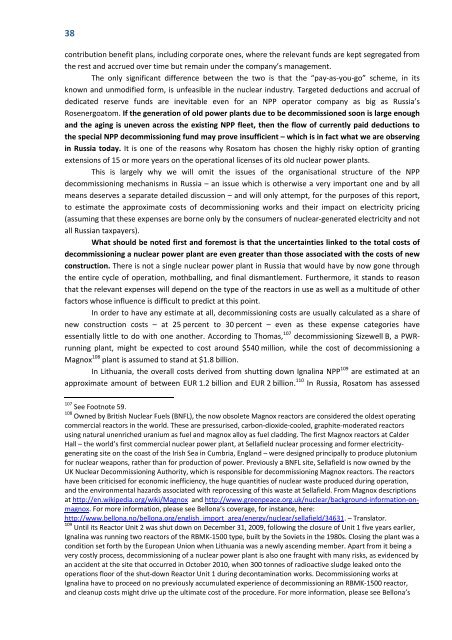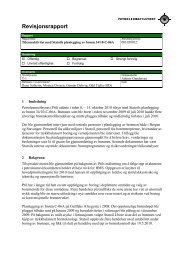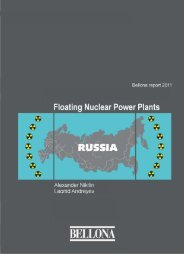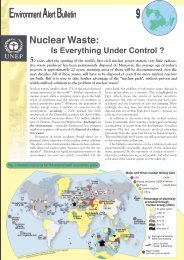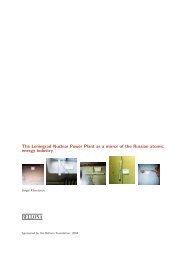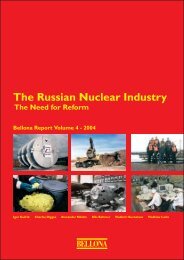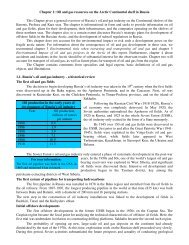38contribution benefit plans, including corporate ones, where <strong>the</strong> relevant funds are kept segregated from<strong>the</strong> rest and accrued over time but remain under <strong>the</strong> company’s management.<strong>The</strong> only significant difference between <strong>the</strong> two is that <strong>the</strong> “pay‐as‐you‐go” scheme, in itsknown and unmodified form, is unfeasible in <strong>the</strong> nuclear industry. Targeted deductions and accrual <strong>of</strong>dedicated reserve funds are inevitable even for an NPP operator company as big as Russia’sRosenergoatom. If <strong>the</strong> generation <strong>of</strong> old power plants due to be decommissioned soon is large enoughand <strong>the</strong> aging is uneven across <strong>the</strong> existing NPP fleet, <strong>the</strong>n <strong>the</strong> flow <strong>of</strong> currently paid deductions to<strong>the</strong> special NPP decommissioning fund may prove insufficient – which is in fact what we are observingin Russia today. It is one <strong>of</strong> <strong>the</strong> reasons why Rosatom has chosen <strong>the</strong> highly risky option <strong>of</strong> grantingextensions <strong>of</strong> 15 or more years on <strong>the</strong> operational licenses <strong>of</strong> its old nuclear power plants.This is largely why we will omit <strong>the</strong> issues <strong>of</strong> <strong>the</strong> organisational structure <strong>of</strong> <strong>the</strong> NPPdecommissioning mechanisms in Russia – an issue which is o<strong>the</strong>rwise a very important one and by allmeans deserves a separate detailed discussion – and will only attempt, for <strong>the</strong> purposes <strong>of</strong> this report,to estimate <strong>the</strong> approximate costs <strong>of</strong> decommissioning works and <strong>the</strong>ir impact on electricity pricing(assuming that <strong>the</strong>se expenses are borne only by <strong>the</strong> consumers <strong>of</strong> nuclear‐generated electricity and notall <strong>Russian</strong> taxpayers).What should be noted first and foremost is that <strong>the</strong> uncertainties linked to <strong>the</strong> total costs <strong>of</strong>decommissioning a nuclear power plant are even greater than those associated with <strong>the</strong> costs <strong>of</strong> newconstruction. <strong>The</strong>re is not a single nuclear power plant in Russia that would have by now gone through<strong>the</strong> entire cycle <strong>of</strong> operation, mothballing, and final dismantlement. Fur<strong>the</strong>rmore, it stands to reasonthat <strong>the</strong> relevant expenses will depend on <strong>the</strong> type <strong>of</strong> <strong>the</strong> reactors in use as well as a multitude <strong>of</strong> o<strong>the</strong>rfactors whose influence is difficult to predict at this point.In order to have any estimate at all, decommissioning costs are usually calculated as a share <strong>of</strong>new construction costs – at 25 percent to 30 percent – even as <strong>the</strong>se expense categories haveessentially little to do with one ano<strong>the</strong>r. According to Thomas, 107 decommissioning Sizewell B, a PWRrunningplant, might be expected to cost around $540 million, while <strong>the</strong> cost <strong>of</strong> decommissioning aMagnox 108 plant is assumed to stand at $1.8 billion.In Lithuania, <strong>the</strong> overall costs derived from shutting down Ignalina NPP 109 are estimated at anapproximate amount <strong>of</strong> between EUR 1.2 billion and EUR 2 billion. 110 In Russia, Rosatom has assessed107 See Footnote 59.108 Owned by British <strong>Nuclear</strong> Fuels (BNFL), <strong>the</strong> now obsolete Magnox reactors are considered <strong>the</strong> oldest operatingcommercial reactors in <strong>the</strong> world. <strong>The</strong>se are pressurised, carbon‐dioxide‐cooled, graphite‐moderated reactorsusing natural unenriched uranium as fuel and magnox alloy as fuel cladding. <strong>The</strong> first Magnox reactors at CalderHall – <strong>the</strong> world’s first commercial nuclear power plant, at Sellafield nuclear processing and former electricitygeneratingsite on <strong>the</strong> coast <strong>of</strong> <strong>the</strong> Irish Sea in Cumbria, England – were designed principally to produce plutoniumfor nuclear weapons, ra<strong>the</strong>r than for production <strong>of</strong> power. Previously a BNFL site, Sellafield is now owned by <strong>the</strong>UK <strong>Nuclear</strong> Decommissioning Authority, which is responsible for decommissioning Magnox reactors. <strong>The</strong> reactorshave been criticised for economic inefficiency, <strong>the</strong> huge quantities <strong>of</strong> nuclear waste produced during operation,and <strong>the</strong> environmental hazards associated with reprocessing <strong>of</strong> this waste at Sellafield. From Magnox descriptionsat http://en.wikipedia.org/wiki/Magnox and http://www.greenpeace.org.uk/nuclear/background‐information‐onmagnox.For more information, please see <strong>Bellona</strong>’s coverage, for instance, here:http://www.bellona.no/bellona.org/english_import_area/energy/nuclear/sellafield/34631. – Translator.109 Until its Reactor Unit 2 was shut down on December 31, 2009, following <strong>the</strong> closure <strong>of</strong> Unit 1 five years earlier,Ignalina was running two reactors <strong>of</strong> <strong>the</strong> RBMK‐1500 type, built by <strong>the</strong> Soviets in <strong>the</strong> 1980s. Closing <strong>the</strong> plant was acondition set forth by <strong>the</strong> European Union when Lithuania was a newly ascending member. Apart from it being avery costly process, decommissioning <strong>of</strong> a nuclear power plant is also one fraught with many risks, as evidenced byan accident at <strong>the</strong> site that occurred in October 2010, when 300 tonnes <strong>of</strong> radioactive sludge leaked onto <strong>the</strong>operations floor <strong>of</strong> <strong>the</strong> shut‐down Reactor Unit 1 during decontamination works. Decommissioning works atIgnalina have to proceed on no previously accumulated experience <strong>of</strong> decommissioning an RBMK‐1500 reactor,and cleanup costs might drive up <strong>the</strong> ultimate cost <strong>of</strong> <strong>the</strong> procedure. For more information, please see <strong>Bellona</strong>’s
39<strong>the</strong> expenses on decommissioning four VVER‐1000 reactors <strong>of</strong> Balakovo NPP at $942.1 million, 111 whichlooks like an underestimation. For instance, <strong>the</strong> general view accepted in <strong>the</strong> Belarusian nuclear circles isthat <strong>the</strong> costs <strong>of</strong> taking a nuclear power plant our <strong>of</strong> operation equal those <strong>of</strong> commissioning one inabsolute values.A wide variety <strong>of</strong> assumptions can be found in studies done on <strong>the</strong> economics <strong>of</strong> nuclear powerwith regard to decommissioning costs – estimates ranging between $250 million to over $2 billion.Experts from <strong>the</strong> International Atomic Energy Agency (IAEA), for instance, hold to a more conservativeassessment <strong>of</strong> between $250 million to $500 million, but <strong>the</strong> very limited global experience in carryingout <strong>the</strong> full cycle <strong>of</strong> decommissioning works at a nuclear industry site has already demonstrated that <strong>the</strong>actual costs incurred tend to exceed noticeably those anticipated in forecast estimates or projectdocumentation.Costs <strong>of</strong> decommissioning a nuclear power plant are high, but <strong>the</strong>y do not play a major role in<strong>the</strong> formal calculation <strong>of</strong> pr<strong>of</strong>itability <strong>of</strong> this or that investment project, since, being deferred farahead into <strong>the</strong> future, <strong>the</strong>y decrease significantly when discounted.<strong>The</strong> issue <strong>of</strong> <strong>the</strong> particular discount rate to be applied is ano<strong>the</strong>r one that leaves much room forspeculation. A low discount rate is normally used to calculate <strong>the</strong> necessary financial reserves todecommission a nuclear power plant with regard to which <strong>the</strong> main expenses will be effected some 100or 140 years after its closure. This is a markedly lower rate than <strong>the</strong> required cost <strong>of</strong> capital calculated in<strong>the</strong> estimates <strong>of</strong> an investment project. This has to do with <strong>the</strong> gigantic time horizon and <strong>the</strong>corresponding uncertainty <strong>of</strong> estimates, as well as <strong>the</strong> overall risks <strong>of</strong> investing into <strong>the</strong> nuclear energyindustry.We shall take for our calculations an assumed site with a typical 1,000‐megawatt reactor and aninterest rate at 3 percent; <strong>the</strong> total decommissioning costs calculated based on <strong>the</strong>se parameters andsplit between decommissioning phases, with <strong>the</strong> last one envisioned 100 years after closure, 112 areshown in Table 11.coverage, for instance, here: http://bellona.org/articles/articles_2010/ignalina_leak andhttp://bellona.org/articles/articles_2010/ignalina_shut_down. – Translator.110 See Footnote 92.111 See Footnote 16.112 NPP decommissioning strategies vary depending on a particular approach to decommissioning time frames. Forinstance, a choice between an immediate start <strong>of</strong> dismantlement operations at <strong>the</strong> shutdown site, mothballing <strong>the</strong>site until radioactivity levels subside enough to allow for <strong>the</strong> desired safety level <strong>of</strong> dismantlement works, and anentombment option is <strong>of</strong>fered in <strong>the</strong> US to power companies envisioning closure <strong>of</strong> a nuclear power plant (see <strong>the</strong>US <strong>Nuclear</strong> Regulatory Commission’s Fact Sheet on Decommissioning <strong>Nuclear</strong> <strong>Power</strong> Plants,http://www.nrc.gov/reading‐rm/doc‐collections/fact‐sheets/decommissioning.html). In <strong>the</strong> case <strong>of</strong> Magnox plantsat Berkley (Gloucestershire, shut down in 1989) and Oldbury (South Gloucestershire, scheduled for shutdown inJune 2011), for instance, a 25‐year and a 100‐year decommissioning strategies were discussed in November 2006(http://www.sitestakeholdergroups.org.uk/oldbury/upload/oldbury_and_berkeley_joint_meeting_minutes_01_nov_06.pdf#page=7). Thomas (see Footnote 59) writes that conventionally, decommissioning is split into threephases: Under Phase I, fuel is removed and <strong>the</strong> reactor is secured; this mostly represents a continuation <strong>of</strong> <strong>the</strong>operations that were under way while <strong>the</strong> plant was in operation. In <strong>the</strong> second phase, <strong>the</strong> uncontaminated orlightly contaminated structures are demolished and removed. (In economic terms, <strong>the</strong> incentive is to delay it aslong as possible to minimise <strong>the</strong> amount that needs to be collected from consumers to pay for it—<strong>the</strong> longer <strong>the</strong>delay, <strong>the</strong> more interest <strong>the</strong> decommissioning fund will accumulate. <strong>The</strong> limiting point is when <strong>the</strong> integrity <strong>of</strong> <strong>the</strong>buildings can no longer be assured and <strong>the</strong>re is a risk <strong>the</strong>y might collapse, leading to a release <strong>of</strong> radioactivematerial. In Britain, it is planned to delay Phase II until 40 years after plant closure, Thomas writes). Phase III is <strong>the</strong>removal <strong>of</strong> <strong>the</strong> reactor core and is <strong>the</strong> most expensive and most technologically challenging, requiring remoterobotic handling <strong>of</strong> materials. As with Phase II, <strong>the</strong> economic incentive is to delay <strong>the</strong> work until it is no longer safeto do so and in Britain, this is expected to result in a delay <strong>of</strong> 135 years. Accordingly, Thomas estimates <strong>the</strong> totalcost <strong>of</strong> decommissioning a Magnox plant ($1.8 billion) as split between phases as above – Phase I carried outimmediately after closure, Phase II after 40 years, and Phase III after 135 years. – Translator.
- Page 2 and 3: …Nuclear power generation is the
- Page 4 and 5: Translator’s notes:Rules of etiqu
- Page 6 and 7: 6ForewordThe economy of the Russian
- Page 8 and 9: 8of everything that the nuclear pow
- Page 10 and 11: 10Real costs of nuclear power plant
- Page 12 and 13: 12Energy Potential Development,”
- Page 14 and 15: 14noticeably higher than the regula
- Page 16 and 17: 16came to 2.2 billion kilowatt‐ho
- Page 18 and 19: 183. Problems of nuclear power indu
- Page 20 and 21: 20requirements: If a wrong decision
- Page 22 and 23: 22Property and liability insurance;
- Page 24 and 25: 24Depreciation 10,911,630 9,312,654
- Page 26 and 27: 26low prices, because a decrease in
- Page 28 and 29: 28Fig. 2. Spot prices for U 3 O 8 c
- Page 30 and 31: 30uranium needs and the demand it h
- Page 32 and 33: 32remains unclear what can be done
- Page 34 and 35: 34For instance, British energy comp
- Page 36 and 37: 36But Rosenergoatom’s real expens
- Page 40 and 41: 40Table 11. Costs of decommissionin
- Page 42 and 43: 42And thirdly, traditional approach
- Page 44 and 45: 44The discount rate will be the var
- Page 46 and 47: 46Cost ofcapitalTable 15. Price of
- Page 48 and 49: 48operation as a baseload generatin
- Page 50 and 51: 505 percent0 percent367.0 614.3 3.7
- Page 52 and 53: 52The idea to develop the sector of
- Page 54 and 55: 54Even if we assume that the direct
- Page 56 and 57: 56Furthermore, the total cost of bu
- Page 58 and 59: 5811. Instructional guidelines for
- Page 60: 60Greenpeace, 01.04.2004,http://www


